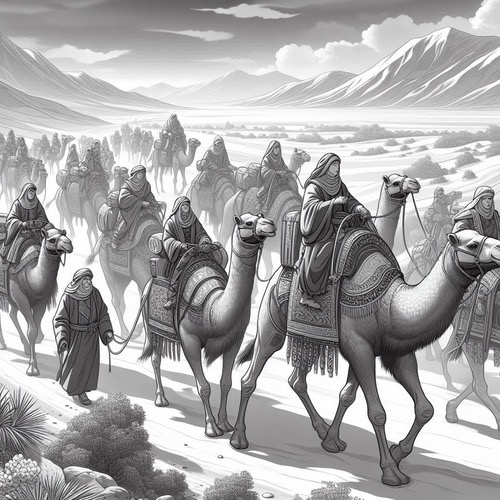Bible Accounts of Ancient Trade: Archaeological Evidence
Ancient trade routes mentioned in the Bible have long fascinated historians and archaeologists alike. Archaeological discoveries along these Middle Eastern trade routes provide evidence that aligns with biblical accounts of commerce. These findings suggest strong geographical and historical correlations between archaeological evidence and biblical descriptions of economic dynamics in the ancient Near East…
KEY DISCOVERIES CONFIRM BIBLE ACCOUNTS OF ANCIENT TRADE ROUTES
The world of ancient Middle Eastern trade routes reveals a complex network of commercial highways that corresponds with Bible narratives. Here are some significant examples:
1. The King’s Highway The King’s Highway was one of antiquity’s most important trade routes, stretching from Egypt through the Sinai Peninsula and modern-day Jordan to Damascus in Syria. It ran roughly parallel to the Jordan River but 35-50 miles to its east, providing a key passage for transporting goods between Arabia, Egypt, and Mesopotamia. The Bible first mentions it in Numbers 20:17, when Moses asked the King of Edom for permission to use the route. Archaeological evidence found along the route includes:
- Fortified way-stations discovered at regular intervals, suggesting organised travel. These way-stations were likely constructed during the Iron Age, a period that overlaps with significant Israelite activity in the region.
- Finds at Kuntillet Ajrud (8th century BCE), indicating trade activity near Edom. This site is also known for its religious inscriptions.
- Moabite ruins at Kir-Hareseth revealed wool-processing facilities, supporting the tribute described in 2 Kings 3:4, where King Mesha of Moab is mentioned.
- Egyptian seals and scarabs, including some with cartouches of Pharaohs Siamun and Sheshonq I (circa 970-920 BCE), suggest Egyptian commercial activity during a period traditionally associated with Solomon’s reign.
2. The Via Maris: The Via Maris (or “Way of the Sea”) was a major coastal trade route linking Egypt to Syria and Mesopotamia, passing through Phoenician ports along the Mediterranean coast. The route is referenced in Isaiah 9:1 as “the way of the sea.” Archaeological evidence shows this route’s significance during multiple periods.
- At Tell Abu Hawam, Phoenician harbour structures dating to the Late Bronze and Iron Ages (1550–586 BCE) have been uncovered, aligning with biblical accounts of Phoenician maritime commerce during Solomon’s reign (circa 970–930 BCE). Excavations at Athlit also reveal evidence of Phoenician sea trade.
- Lebanese cedar remains found at Megiddo, likely used in construction during the period of Solomon’s alliance with Hiram of Tyre (1 Kings 5:6-11).
- Egyptian trade goods found along the coastal route, consistent with biblical descriptions of international trade patterns.
- Egyptian artefacts have been found in coastal Canaanite cities like Ashkelon, consistent with trade exchanges described in Ezekiel 27.
3. The Incense Route: The Incense Route connected southern Arabia (modern Yemen and Oman) through the Negev Desert to Mediterranean ports, transporting precious commodities like frankincense and myrrh. This route gained prominence during Solomon’s reign, particularly when the Queen of Sheba travelled to visit him (1 Kings 10). Archaeological findings along this route include:
- Excavations at Tell el-Kheleifeh (possibly biblical Ezion-Geber) revealed copper smelting facilities, supporting biblical references to industrial activity under Solomon’s reign.
- Residues of aromatic substances found in storage vessels align with biblical mentions of frankincense and myrrh, such as in 1 Kings 10:10.
- Camel bones found at southern Arabian outposts, radiocarbon dated to the early first millennium BCE, support the biblical narrative of camel caravans in the region.
- Metallurgical installations in the Arabah Valley correspond to copper mining and smelting activities that some scholars associate with passages like 1 Kings 9:26-28.
ARCHAEOLOGICAL EVIDENCE SUPPORT BIBLE ACCOUNTS OF ANCIENT TRADE
Trade Documentation Matches Scripture: Commercial records discovered through cuneiform tablets, ancient receipts, and diplomatic correspondences bear remarkable resemblance to biblical descriptions of trade. Some notable findings include:
- Cuneiform tablets found at Tel Dan reference ‘The House of David,’ offering valuable corroboration of a Davidic dynasty.
- Weights found in excavations at trade sites show a system consistent with the biblical shekel.
- Phoenician inscriptions mentioning trade during Solomon’s time.
- Egyptian records indicating trade relations with Canaan/Israel during the biblical period.
Material Evidence Supports Biblical Descriptions: Archaeological excavations have uncovered physical artefacts that align with biblical trade descriptions, though the exact link to specific events remains debated. Examples include:
- Purple dye installations in Tyre, reflecting the city’s significant role in luxury goods trade as described in the Bible.
- Lebanese cedar beams used in building projects confirm the timber trade mentioned in biblical texts.
- Gold artefacts found along ancient Arabian trade routes align with biblical references to wealth from regions like Ophir (1 Kings 9:28, 10:11), though the exact location of Ophir remains uncertain.
- Ivory carvings and ape bones discovered in Mediterranean ports suggest exotic imports that may echo the luxurious items listed in 1 Kings 10:22.
Scientific Dating Aligns With Biblical Timelines: Modern dating methods, such as radiocarbon dating and pottery seriation, have aligned the timelines of ancient trade hubs with biblical narratives. For instance:
- Radiocarbon dating of wooden beams from Ezion-Geber matches the 10th century BCE, placing it within the biblical timeline of Solomon’s reign.
- Pottery sequences from Megiddo also suggest commercial expansion during this period.
Technological Evidence Supports Biblical Accounts: Recent technological advances have contributed to mapping ancient trade routes and confirming biblical accounts:
- Ground-penetrating radar and satellite imagery have helped archaeologists trace ancient routes, such as the Via Maris and the Incense Route, in line with biblical descriptions.
- Chemical analysis of artefacts has confirmed the origin of metals and goods traded across the Near East, supporting biblical references to trade networks.
Conclusion: Archaeological Evidence Supports Biblical Narratives
While not all archaeological findings can be tied to specific biblical events, the convergence of evidence from artefacts, trade routes, and scientific methods offers substantial support for the historical reliability of the Bible’s descriptions of ancient trade. This evidence provides valuable insights into the commercial and geopolitical dynamics of the ancient Near East.
Bible Accounts of Ancient Trade: Related FAQs
- What were the main trade routes mentioned in the Bible? The Bible references several significant trade routes, including the King’s Highway and the Via Maris, which facilitated the movement of goods like spices, timber, and luxury items between Egypt, Mesopotamia, Arabia, and Israel. Archaeological findings, such as way-stations and harbour structures along these routes, correspond to the Bible’s descriptions of these ancient highways.
- How does archaeology confirm the existence of biblical trade routes? Archaeological discoveries, such as fortified caravanserais, harbour installations, and artefacts like pottery and luxury goods, have been found along routes mentioned in the Bible. Dating techniques, including radiocarbon dating and stratigraphy, indicate these routes were active during the periods described in biblical texts, lending support to the historical accuracy of these accounts.
- What goods were traded along ancient biblical trade routes? Valuable items such as frankincense, myrrh, gold, ivory, cedarwood, and purple dye were traded along biblical routes. The Bible mentions these goods in relation to trade activities involving Solomon, Phoenicia, Egypt, and Sheba. Archaeological evidence—including ivory carvings, dye production sites, and camel bones—supports the trade of such luxury items along these routes.
- Did King Solomon control any major trade routes? The Bible attributes control of key trade routes, such as the Incense Route and the King’s Highway, to King Solomon. His reign is associated with a prosperous trade network involving gold, spices, and other luxury items. Archaeological sites, including copper smelting facilities at locations like Ezion-Geber, align with descriptions of Solomon’s commercial enterprises along these routes.
- What role did the Phoenicians play in biblical trade? The Phoenicians, especially during King Solomon’s reign, played a major role in maritime trade along routes like the Via Maris. Known for their expertise in shipbuilding and trade of luxury goods like purple dye and cedarwood, the Phoenicians’ harbours and trade networks, as revealed in excavations, support the biblical accounts of their commerce with Israel and neighbouring regions.
Bible Accounts of Ancient Trade: Our Related Posts
Editor's Pick

Christian Obedience: God’s Empowerment or an Act of Our Will?
Every Christian knows the struggle. You’re fighting a besetting sin—again. You’ve resolved to do better—again. And you’re wondering: Should I [...]

The Throne-Room Vision: Who Did Isaiah See?
The scene is unforgettable: Isaiah stands in the temple, and suddenly the veil between heaven and earth tears open. He [...]

The Angel of the Lord: Can We Be Certain It Was Christ All Along?
Throughout the Old Testament, a mysterious figure appears: the Angel of the LORD. He speaks as God, bears God’s name, [...]
SUPPORT US:
Feel the Holy Spirit's gentle nudge to partner with us?
Donate Online:
Account Name: TRUTHS TO DIE FOR FOUNDATION
Account Number: 10243565459
Bank IFSC: IDFB0043391
Bank Name: IDFC FIRST BANK






